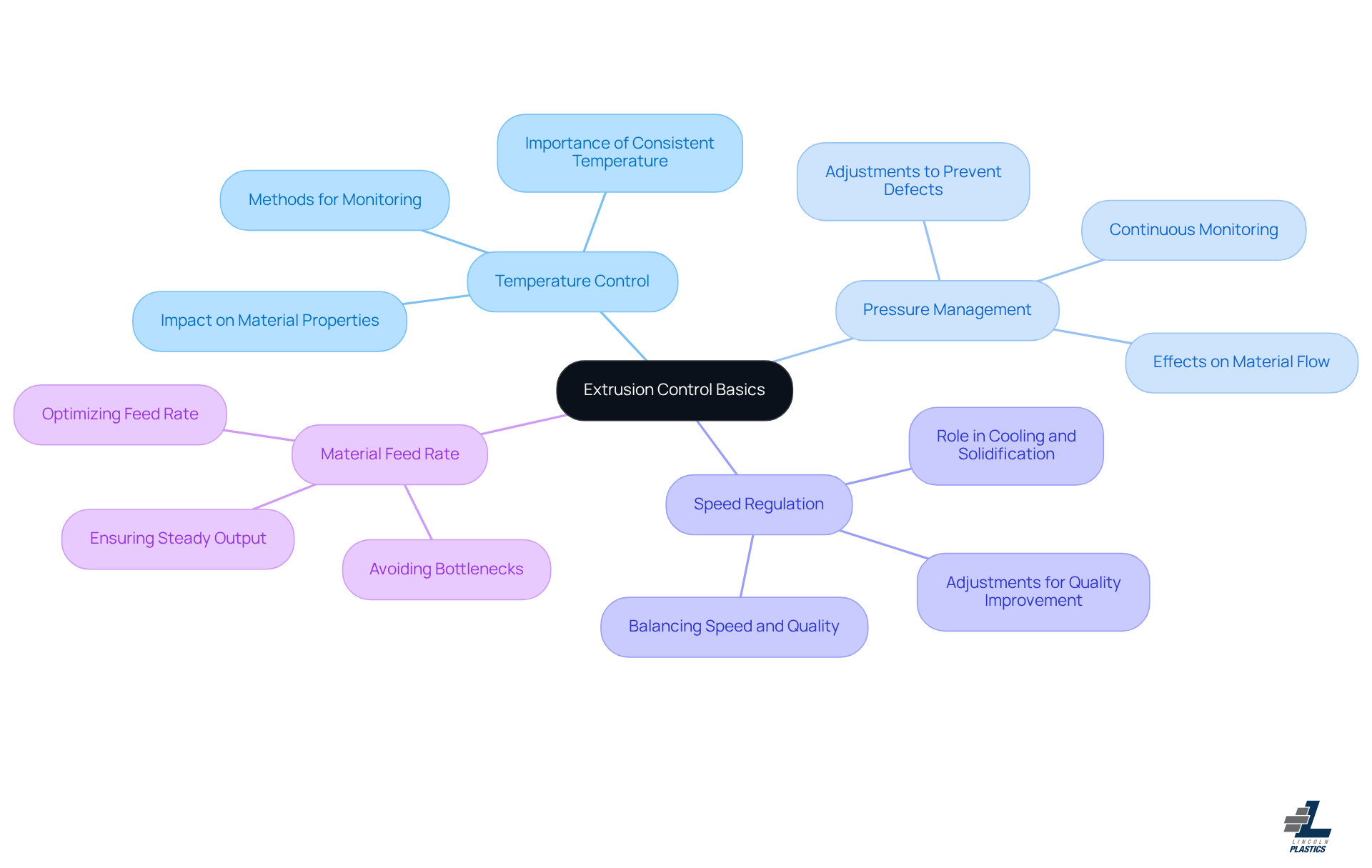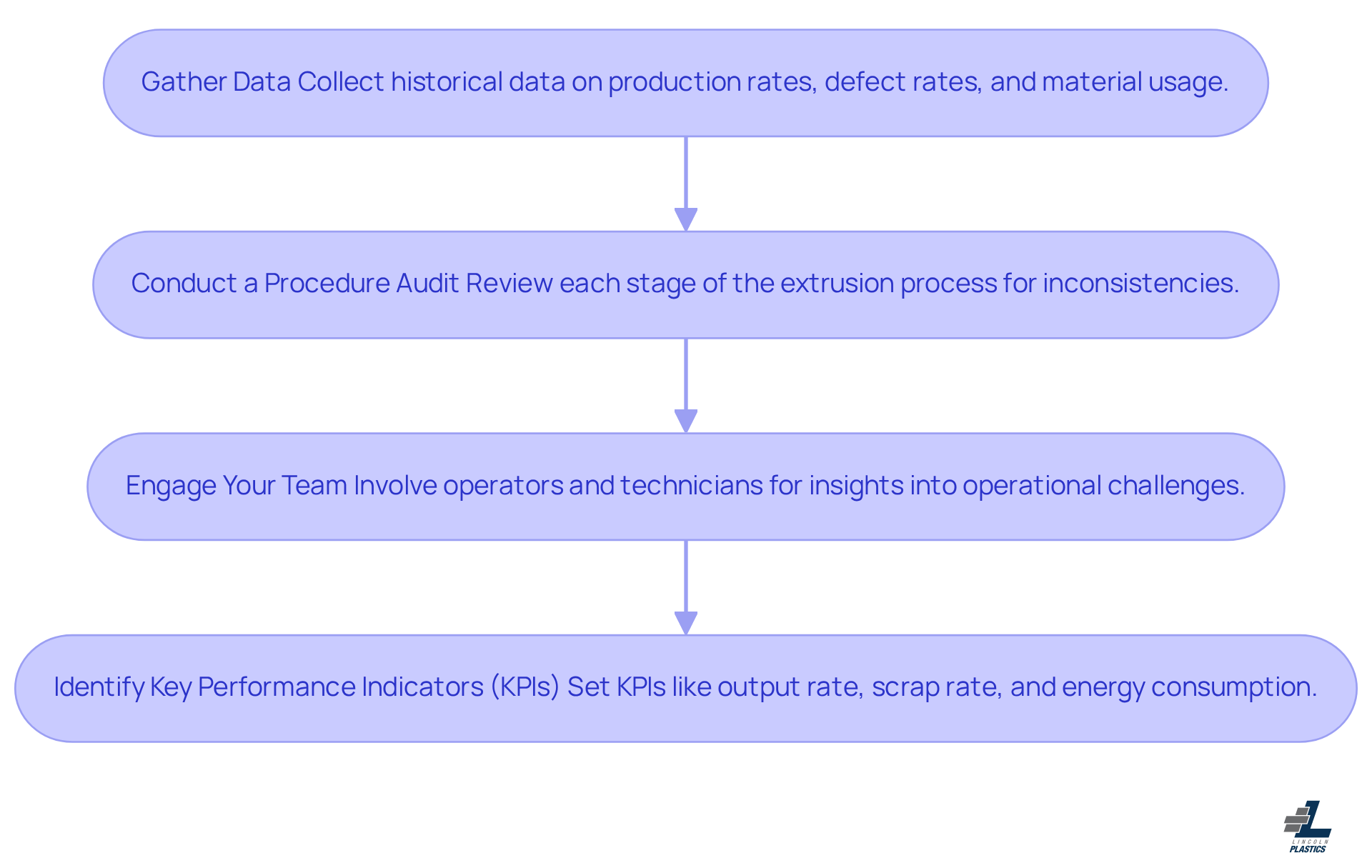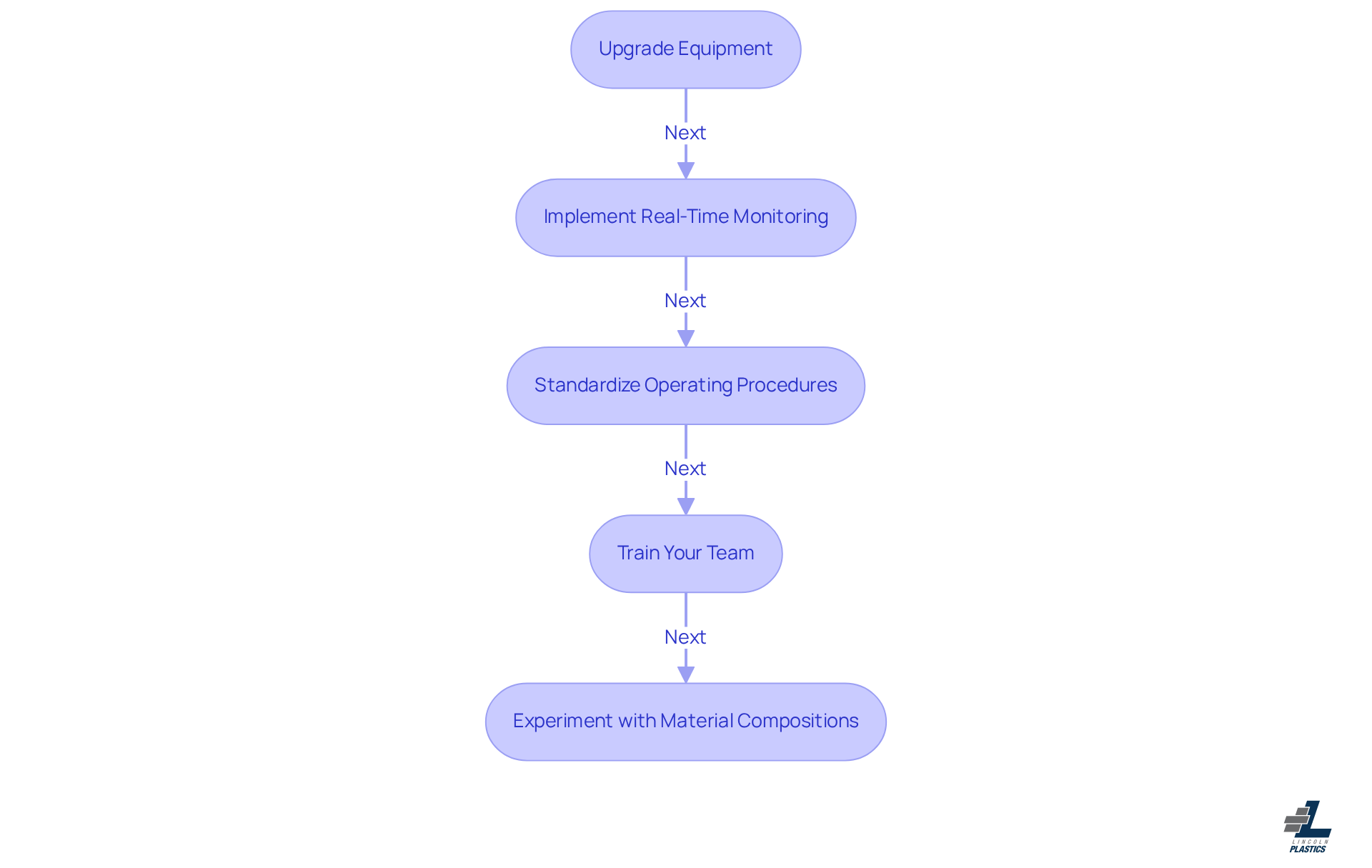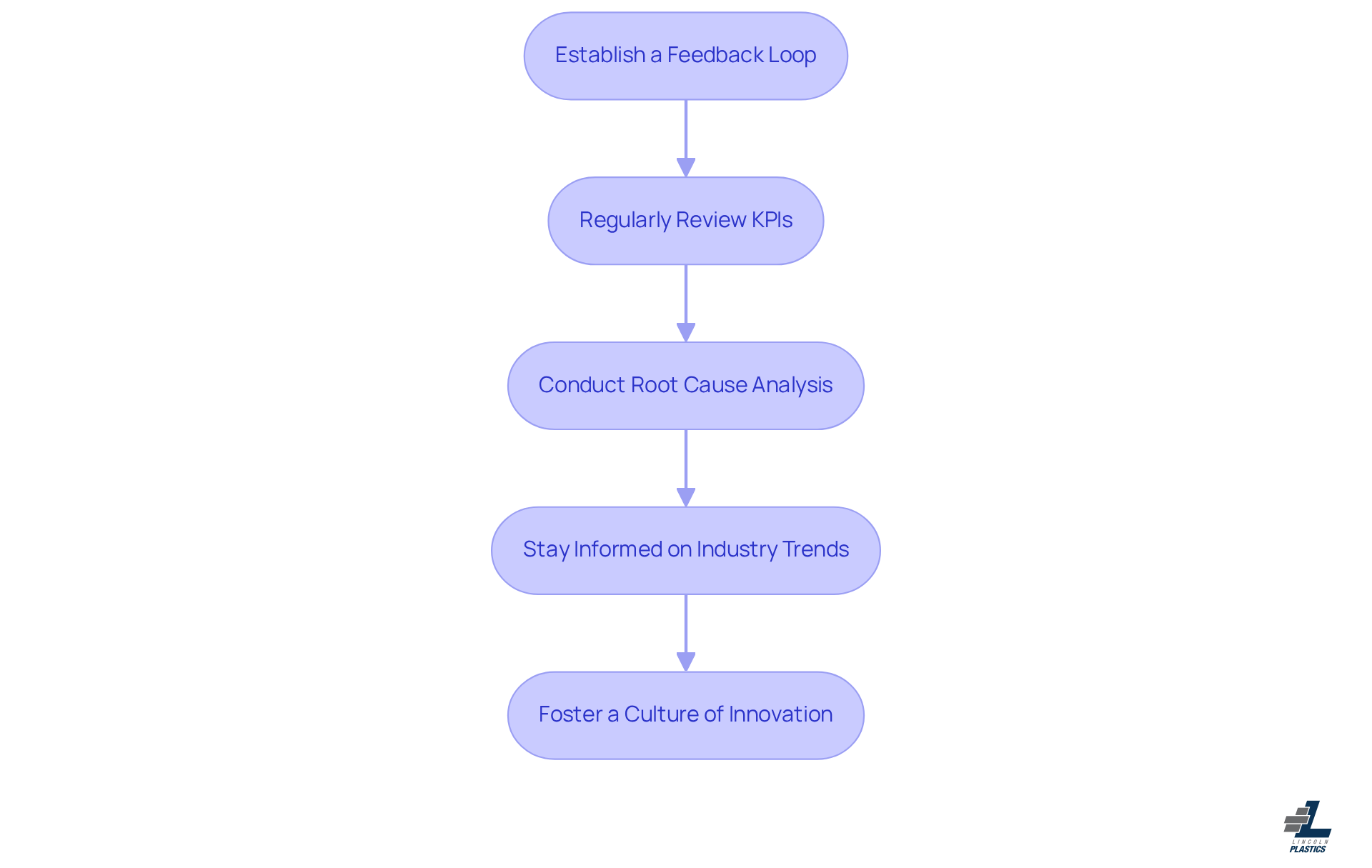
Master Extrusion Control: 4 Steps to Optimize Your Process
Overview
Let’s dive into optimizing extrusion control! It all starts with four key steps:
- Understanding the basics
- Assessing your current process
- Implementing some optimization strategies
- Ensuring continuous improvement
Each step highlights important factors like temperature, pressure, and speed management. Plus, collecting data and engaging your team can really boost product quality and operational efficiency in your extrusion processes.
Now, you might be wondering how to get started. Think about the challenges you face in your current setup. By addressing these issues with the right strategies, you can make a significant impact. Remember, it’s all about keeping things running smoothly and efficiently!
So, what are you waiting for? Let’s take these steps together and enhance your extrusion process!
Introduction
Mastering the ins and outs of extrusion control can really unlock better product quality and smoother operations. By getting a grip on the basics—like temperature, pressure, and speed—you can significantly boost your processes. But let’s be real, navigating these variables can be quite the challenge, right?
So, what steps can we take to not just assess but also optimize extrusion control? How can we ensure consistent output and fewer defects? Let’s dive in!
Understand the Basics of Extrusion Control
Managing extrusion isn’t just about the technicalities; it’s about ensuring that what comes out meets the standards we all expect. Let’s break down some key components that make extrusion control effective:
- Temperature Control: Keeping the right temperature throughout the extrusion process is super important for getting the material properties just right. If temperatures fluctuate, you might end up with products that don’t meet the standards, so nailing this aspect is crucial.
- Pressure Management: You’ll want to keep an eye on the pressure in the extruder. Continuous monitoring and adjustments help prevent defects and keep the material flowing smoothly. Effective extrusion control can significantly reduce issues such as material deterioration or inconsistent output.
- Speed Regulation: The speed at which shaping occurs plays a huge role in how the material cools and solidifies, which directly affects the quality of the final product. Tweaking the speed can lead to better results in the shaping process.
- Material Feed Rate: It’s all about optimizing how raw materials feed into the extruder. A steady feed rate helps maintain output and avoids bottlenecks, making sure the shaping process runs like a well-oiled machine.
Understanding these key elements can help you spot areas for improvement in your extrusion control methods. For instance, in a case study about shaping a locating strip for the automotive sector, we found that precise temperature and pressure regulation really boosted assembly methods. This just goes to show how vital these factors are for achieving high-quality results. Similarly, a project focused on board edging for office furniture demonstrated how efficient temperature management can enhance both the look and functionality of the product. It’s clear that effective shaping regulation is key to driving product innovation. So, what steps will you take to enhance your extrusion processes?

Assess Your Current Extrusion Control Process
To effectively assess your current extrusion control process, let’s follow these steps together:
-
Gather Data: Start by collecting historical data on production rates, defect rates, and material usage. This info is crucial for spotting trends and identifying where things might be going wrong. For instance, did you know that defect rates in shaping methods can significantly impact overall efficiency? Research shows that up to 20% of shaped items might not meet standards due to insufficient data monitoring. At Lincoln Plastics, we prioritize accurate data collection to ensure we meet quality requirements for OEMs.
-
Conduct a Procedure Audit: Now, let’s talk about reviewing each stage of the extrusion process, from material prep to final product inspection. Keep an eye out for inconsistencies in temperature, pressure, and speed. Ongoing observation of these factors is key; companies that implement strict auditing methods often report a 15% decrease in defects. At Lincoln Plastics, our robust quality system includes critical in-process checks and various gauges to ensure all products meet specified dimensions and functionality.
-
Engage Your Team: Don’t forget to involve your operators and technicians in the evaluation process! Their hands-on experience can provide valuable insights into operational challenges. Industry leaders emphasize that frontline workers are vital for spotting inefficiencies since they’re directly engaged with the machinery and operations. At Lincoln Plastics, we believe that collaborating with our team enhances our ability to deliver tailored solutions that meet OEM specifications.
-
Identify Key Performance Indicators (KPIs): Next up, let’s set some KPIs that reflect how effective your production method is. Common KPIs include output rate, scrap rate, and energy consumption. By establishing clear KPIs, you can target your improvements; organizations that track these metrics can see up to a 25% boost in productivity. Lincoln Plastics highlights these metrics to ensure our tailored manufacturing solutions not only meet but exceed industry standards.
By taking a close look at your existing system, you can pinpoint where improvements in extrusion control are needed, ultimately boosting operational efficiency and product quality. So, are you ready to dive in and start making those changes?

Implement Optimization Strategies for Extrusion Control
To optimize your extrusion control process, let’s explore some strategies together:
-
Upgrade Equipment: Have you thought about investing in some modern machinery? Upgrading to equipment with advanced management features—like automated temperature and pressure regulation—can really boost precision. Plus, it fits right in with the industry's move towards energy-efficient solutions. For instance, did you know that twin-screw extruders can use about 30% less power than single-screw ones?
-
Implement Real-Time Monitoring: Consider using sensors and software to keep an eye on key parameters in real-time. This way, you can make immediate adjustments, which can significantly cut down on defects. Research shows that implementing extrusion control can lead to a 20-40% drop in pressure fluctuations, enhancing stability and product quality.
-
Standardize Operating Procedures: What about developing and documenting standard operating procedures (SOPs) for your extrusion process? This ensures consistency and helps new operators get up to speed quickly, fostering a culture of excellence and efficiency. Our quality system even includes a dedicated quality book for your plastic profile, complete with drawings and critical checks to support this standardization.
-
Train Your Team: Don’t forget to invest in your team! Offering ongoing education on best practices in material processing control is crucial. A well-informed team is key to maintaining high-quality production, especially as automation and Industry 4.0 technologies become more prevalent in manufacturing.
-
Experiment with Material Compositions: Why not collaborate with your suppliers to explore different material compositions? This could enhance your shaping methods and improve the final product's attributes. Innovations in material science can lead to better performance and sustainability, which is increasingly important in our eco-conscious industry. At Lincoln Plastics, we can help you source colors that meet your Pantone specifications for consistency across manufacturers.
By putting these tactics into action, you can really boost the effectiveness and quality of your production processes, positioning your business to meet the evolving market needs.

Monitor and Adjust for Continuous Improvement
To keep improving your extrusion control process, let’s look at some helpful guidelines:
-
Establish a Feedback Loop: Start by setting up a solid system to gather input from operators and control personnel. This feedback is super important for spotting areas that need attention and improvement. Regular feedback helps you understand customer needs and preferences, which leads to better products and services. At Lincoln Plastics, we work closely with OEMs to make sure their products meet all standards, including special checks for ‘fit and function’.
-
Regularly Review KPIs: Make it a habit to review your Key Performance Indicators (KPIs) consistently. This will help you analyze performance trends and discover new opportunities for improvement. Regular KPI assessments are crucial for maintaining extrusion control, as they can significantly boost your operational efficiency. Our robust assurance system includes a handy reference book for your plastic profile, complete with illustrations, essential in-process checks, and run documentation to support these evaluations.
-
Conduct Root Cause Analysis: If you encounter defects, take the time to perform a thorough root cause analysis to find out what’s really going on. This proactive approach allows you to implement corrective actions that can prevent future issues. By using various types of check gauges, we ensure a proper end-use fit, which is key to maintaining high quality standards.
-
Stay Informed on Industry Trends: Keep yourself updated on the latest advancements in extrusion technology and materials. Adapting to new trends not only enhances your methods but also gives you a competitive edge in the market. At Lincoln Plastics, we can easily source colors that match your Pantone specifications for consistency across manufacturers, ensuring your products stay competitive.
-
Foster a Culture of Innovation: Encourage your team to share fresh ideas and solutions for improving workflows. A collaborative environment really sparks innovation, leading to better efficiency and productivity. Involving all relevant stakeholders in the feedback process can enrich your improvement strategies.
By committing to ongoing monitoring and adjustments, you can achieve extrusion control while maintaining high standards of quality and efficiency in your production processes. This dedication to continuous improvement is vital for keeping a competitive advantage in the extrusion industry.

Conclusion
Mastering extrusion control is super important for achieving top-notch production outcomes. When you get the hang of the basics—like temperature, pressure, speed, and material feed rate—you can really boost your extrusion processes. This isn’t just about fixing immediate issues; it’s about laying the groundwork for ongoing improvements. That way, your products can meet industry standards and keep customers happy.
So, how do you optimize extrusion control? The article lays out a straightforward path through:
- Data collection
- Procedure audits
- Team engagement
- Setting up key performance indicators
Each of these steps helps you get a better grip on your current operations and spot areas that could use a little polish. By implementing strategies like upgrading equipment, real-time monitoring, and continuous training, you can see some serious gains in productivity and product quality. It really shows how crucial a proactive approach is in this field.
Now, let’s talk about the journey toward effective extrusion control—it’s all about continuous improvement. By creating a culture that values feedback, regularly reviewing performance metrics, and staying in the loop with industry trends, organizations can keep their competitive edge. Embracing these practices doesn’t just elevate production standards; it also helps businesses adapt and thrive in a market that’s always changing. Taking action today can lead to big advancements in extrusion control, paving the way for innovation and excellence in manufacturing.
Frequently Asked Questions
What is the importance of temperature control in extrusion?
Temperature control is crucial in the extrusion process as it ensures that the material properties are maintained. Fluctuations in temperature can lead to products that do not meet quality standards.
How does pressure management affect extrusion?
Pressure management involves continuous monitoring and adjustments to prevent defects and ensure smooth material flow. Effective pressure control can significantly reduce issues like material deterioration and inconsistent output.
Why is speed regulation important in the extrusion process?
Speed regulation affects how the material cools and solidifies during shaping, which directly impacts the quality of the final product. Adjusting the speed can lead to improved results in the shaping process.
What role does material feed rate play in extrusion control?
Optimizing the material feed rate is essential for maintaining a steady output and avoiding bottlenecks in the extrusion process. A consistent feed rate ensures that the shaping process operates efficiently.
Can you provide examples of successful extrusion control?
Yes, in a case study involving a locating strip for the automotive sector, precise temperature and pressure regulation improved assembly methods. Another project on board edging for office furniture showed that efficient temperature management enhanced both the appearance and functionality of the product.
List of Sources
- Understand the Basics of Extrusion Control
- 10 Key Insights on Plastic Extruder Profiles for OEMs (https://lincoln-plastics.com/news-post/10-key-insights-on-plastic-extruder-profiles-for-oe-ms?dcc2137a_page=2)
- Paul Murphy Plastics: Takes Control Over Melt Temperature for Superior Extrusions (https://paulmurphyplastics.com/industry-news-blog/paul-murphy-plastics-takes-control-over-melt-temperature-for-superior-extrusions)
- Assess Your Current Extrusion Control Process
- Global Aluminum Extrusion Market Expected to Reach USD 185.2 Billion by 2033 | IMARC Group (https://imarcgroup.com/aluminium-extrusion-market-statistics)
- Aluminum Extrusion Market | Global Market Analysis Report - 2035 (https://futuremarketinsights.com/reports/aluminium-extrusions-market)
- Powder Blender with Material Handling System at PolySource LLC (https://tsm-controls.com/blog/case_studies/powder-blending-with-material-handling-and-railcar-system-at-polysource)
- Quality Control in Plastic Extrusion for Consistent Results | Rocal (https://rocalextrusions.co.uk/news/quality-control-in-plastic-extrusion-to-ensure-consistent-results)
- Implement Optimization Strategies for Extrusion Control
- How to Collect & Interpret Process Data in Extrusion (https://ptonline.com/articles/how-to-collect-interpret-process-data-in-extrusion-part-1(2))
- Extrusion Machinery Market Size, Share, and Business Dynamics 2025-2032 (https://skyquestt.com/report/extrusion-machinery-market)
- Plastic Extrusion Machine Market Size & Share Report, 2030 (https://grandviewresearch.com/industry-analysis/plastic-extrusion-machine-market-report)
- Use Pressure Control to Minimize Process Variations in Single-Screw Extrusion (https://ptonline.com/articles/use-pressure-control-to-minimize-process-variations-in-single-screw-extrusion)
- Process monitoring and control strategies in extrusion-based bioprinting to fabricate spatially graded structures (https://sciencedirect.com/science/article/abs/pii/S2405886620300531)
- Monitor and Adjust for Continuous Improvement
- Feedback Loops: Creating Mechanisms for Continuous Improvement (https://linkedin.com/pulse/feedback-loops-creating-mechanisms-continuous-malaviarachchi-ybwqc)
- Case studies – TSM Controls Systems (https://tsm-controls.com/blog/case_studies)


